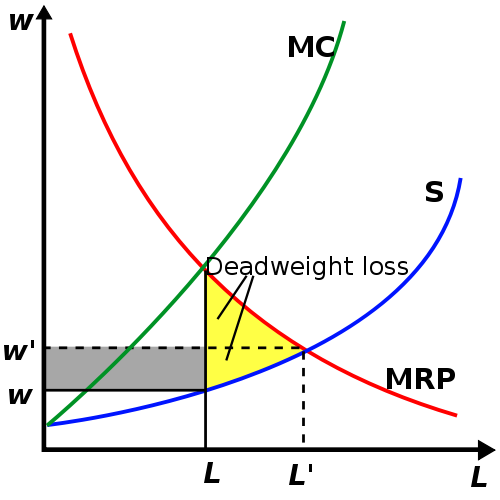- Monopsony occurs when there is one buyer and many sellers.
- In the labour market, a monopsony occurs with one employer and many workers wanting to gain employment.
- Arguably, monopsony power enables firms to ‘exploit’ workers by setting lower wages and employing fewer workers than in a competitive market.
To visualise monopsony power, we could think of a coal mining town in the nineteenth century. In these towns, the principal source of employment was a coal mine owner (or cotton mill owner). If workers couldn’t get employment in the coal mine, or cotton mill there were few other alternatives. Hence we can understand why workers in the Victorian era were often facing low wages and dreadful conditions.
In this case of monopsony power, the coal mine owner has the ability to be a wage setter. A monopsony can pay wages lower than in a competitive market.
Diagram of Monopsony Exploitation

The marginal cost of employing extra workers increases at a faster rate than the average cost. Because if you increase the wage rate to attract more workers, you have to pay everyone a higher wage.
A monopsony maximises profits by employing a quantity of workers where MR = MC (Q2). This means they only have to pay a wage of W2. This is lower than wage in a competitive market (W1), there are also fewer workers employed.
This represents market failure.

- There is a transfer of income from workers to owners (grey area) (increasing income inequality)
- There is also deadweight welfare loss (yellow triangle). This shows the loss of earnings that are not captured by the employer.
Monopsony in Modern Economy
It makes sense that a mill owner in Victorian Britain had monopsony power. However, do firms have monopsony power today? There is much greater diversity in the economy. Workers are rarely faced with a single employer in a town.
Arguably, despite a theoretical choice of employers, in practice, many workers find it difficult to ‘choose employers’ or move jobs.
Sources of Monopsony Power
- Government employer. Many modern pure monopsonies are government jobs. For example, police, fireman have only one potential employer – the government. To a lesser extent, nurses and teachers face little choice apart from government. However, the government doesn’t set wages like a profit maximising firm, but due to other factors.
- Unemployment. When unemployment is high, arguably firms gain more monopsony power. Someone who has unsuccessfully applied for many jobs is more willing to accept lower wages to get a job.
- Lack of Information. The theory of competitive labour markets assumes that workers have access to different job wage rates and potential sources of employment. But, in practice, it is difficult to have all the relevant information.
- Geographical Immobility. Often work is chosen on grounds of geographical proximity or other non-wage factors (rather than wage rates). Therefore, even if higher paid work may be available elsewhere, it is not worth the extra commute.
- Shift Patterns. Many workers (especially part-time / parents with families) may have limited hours they can work. A firm which allows flexible working hours to pick up children may be the only realistic choice for a worker. Therefore, this gives the employer monopsony power.
- Difficulties in moving jobs. Workers have a great reluctance to leave work. You can’t just change jobs like deciding to buy a different type of cereal. A worker will lose on the job training, and firms are reluctant to employ workers who have a habit of moving frequently to get slightly higher pay.
- Monopoly power in selling products. A firm with monopoly selling power is more likely to have a degree of monopsony power.
Therefore, for many part-time / low skilled workers, they face relatively few job opportunities with very limited ability to bargain for higher wages. Therefore, many modern companies have a degree of monopsony power / oligopsony power in employing workers. This has implications for minimum wages/living wages
Arguably, the growth in part-time service sector jobs has increased firms monopsony power and is one reason behind the growth in UK income inequality.
Problems of Monopsony Exploitation in Labour Markets
- Lower wages
- Increased wage inequality
- Workers lack bargaining power in getting improved working conditions.
- Reduced labour productivity due to lack of motivation and feeling of being valued.
Efficiency Wage Theory and Monopsony
Arguably firms may choose not to exercise their monopsony power in setting profit maximising wage. Setting higher wages and improving labour market conditions might increase labour market productivity and loyalty. Efficiency wage theory
Monopsony Exploitation in Product Markets
Firms can have monopsony power in buying raw materials/goods. For example, it is argued that supermarkets abuse their monopsony power to pay low prices to farmers for goods like milk and butter. If farmers don’t sell to supermarkets at a low price, they have no alternative buyer willing to purchase large quantities.
Related

Very nice blog